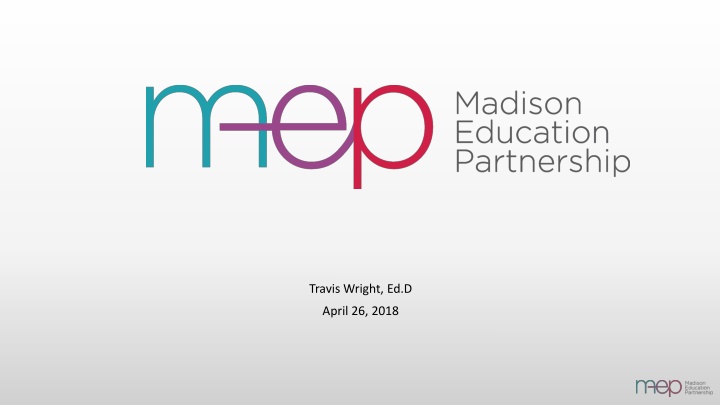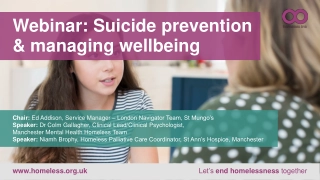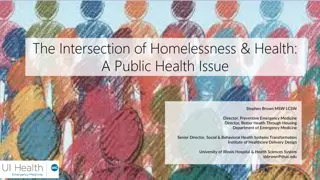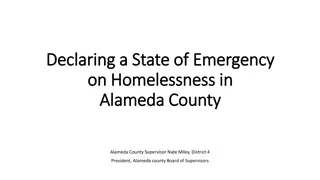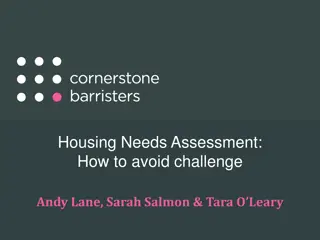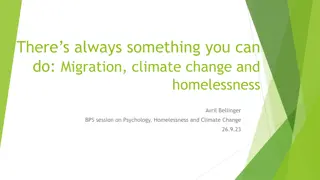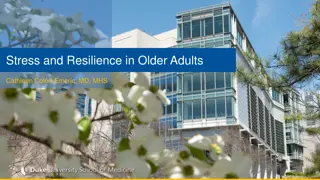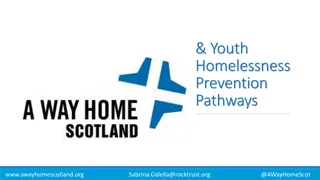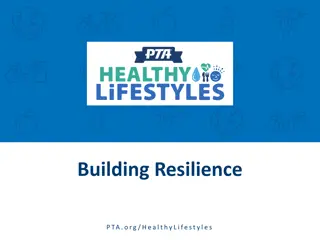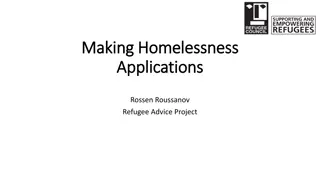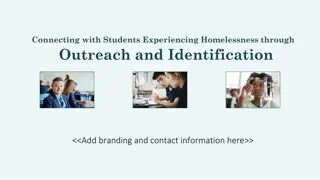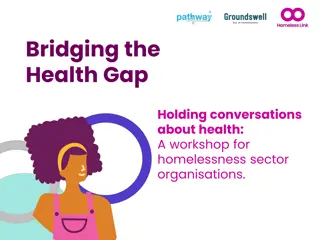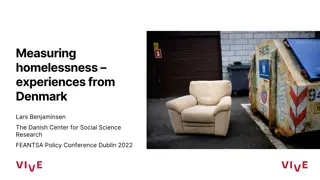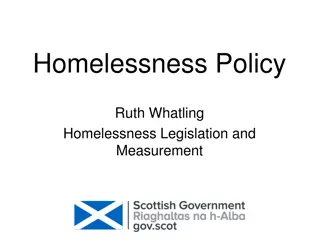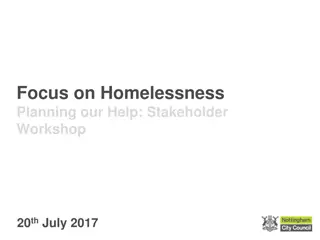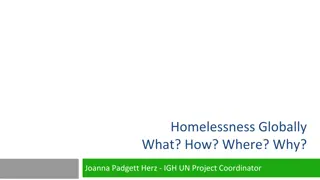Addressing Homelessness Among Children: Urgent Need and Pathways to Resilience
The prevalence of child homelessness in the United States and Madison, its consequences, and the impact of MMSD 4K on homeless children are highlighted. Key findings reveal disparities in educational participation and performance, emphasizing the need for interventions to support resilience in homeless youth.
Download Presentation

Please find below an Image/Link to download the presentation.
The content on the website is provided AS IS for your information and personal use only. It may not be sold, licensed, or shared on other websites without obtaining consent from the author.If you encounter any issues during the download, it is possible that the publisher has removed the file from their server.
You are allowed to download the files provided on this website for personal or commercial use, subject to the condition that they are used lawfully. All files are the property of their respective owners.
The content on the website is provided AS IS for your information and personal use only. It may not be sold, licensed, or shared on other websites without obtaining consent from the author.
E N D
Presentation Transcript
Travis Wright, Ed.D April 26, 2018
Responding to a Critical Need In the United States, approx. 1 in 45 children are homeless. In Madison, 1 in 20 children under age 6 are homeless. 1250 homeless students attending MMSD 350 are enrolled in PK-1st grade. Currently, in Madison, 530 children under age 6 live in homeless shelters. In 2015 alone, there was a 188% (26 to 75) increase in the number of families seeking Early Head Start services for children under age 3. The vast majority of resources are focused on the needs of adolescents experiencing homelessness.
Consequences of Homelessness Associated with risk across all major developmental tasks of childhood. 47% struggle with emotional problems 37% exhibit aggressive behaviors Lower levels of academic achievement and increased risk for suspension, expulsion, and identification for special education. However, many children do not conform to these risk trajectories, suggesting that intervening experiences may support the resilience of children experiencing homelessness.
Pathways to Resilience for Children Experiencing Homelessness How does MMSD 4K impact young children experiencing homelessness? How do young children experiencing homelessness and their families perceive and experience MMSD 4K? What are the opportunities for intervention to support the resilience for young children experiencing homelessness?
Key Findings Children experiencing homelessness are half as likely to participate in MMSD 4K as their more affluent peers. Children experiencing homelessness in 4K or Kindergarten perform 1/3 of a standard deviation lower on all report card measures in Kindergarten than children from other low-income households and 2/3 lower than non-economically disadvantaged children.
Key Findings Kindergarten Math Performance 1.600 1.500 1.400 1.300 1.200 1.100 1.000 No Disadvantage FRL TEP School Community No 4K
Key Findings First Grade Second Grade 1.600 1.800 1.700 1.500 1.600 1.400 1.500 1.300 1.400 1.300 1.200 1.200 1.100 1.100 1.000 1.000 No Disadvantage FRL TEP No Disadvantage FRL TEP Second Grade School Second Grade Community Second Grade No 4K School Community No 4K
Child Behavior Problems Child Behavior Checklist Summary Parent Report Teacher Report N Percent N Percent Total Problems Any subscale in clinical range 12 44.44 7 31.82 Total problems in clinical range 5 18.52 4 18.18 Internalizing Any subscale in clinical range 9 33.33 4 18.18 Total internalizing problems in clinical range 5 18.52 2 9.09 Emotionally Reactive 8 29.63 2 9.09 Anxious Depressed 4 14.81 2 9.09 Somatic Complaints 3 11.11 2 9.09 Withdrawn 4 14.81 3 13.64 Externalizing Any subscale in clinical range 8 29.63 6 27.27 Total externalizing problems in clinical range 5 18.52 4 18.18 Attention Problems 8 29.63 5 22.73 Aggressive Behavior 3 11.11 4 18.18 Sleep problems 4 14.81 -- -- N 27 22
Timing and Chronicity The younger the child at the time of homelessness, the greater the impact of homelessness on academic achievement. Attendance and behavior are most directly impacted during the year in which homelessness was experienced. Attendance and behavior are highly correlated. Chronicity matters. Children experiencing homelessness for two years perform worse than children identified as homeless in only one year. (In this sample, three years is not associated with lower outcomes than two years, but the sample size is very small.)
Program Variables Children experiencing homelessness seemed to benefit most from school-based 4K. Children experiencing homelessness transition best to kindergarten when they attend 4K and Kindergarten in the same school, attend 4K with higher concentrations of children whose parents attended college, and, for behavioral outcomes, are the same race as their teacher.
Classroom Rating System CLASS Results School-Based Min 0.72 0.91 0.07 1.01 1.51 Community-Based SD 0.84 1.05 0.45 0.79 1.28 Mean SD Max Mean Min Max Emotional Support Positive Climate Negative Climate Teacher Sensitivity Regard for Student Perspectives 5.86 6.31 1.02 5.50 4.95 4.00 3.70 1.00 2.70 2.70 6.67 7.00 1.25 6.50 7.00 5.60 5.70 1.30 5.00 5.15 4.50 4.00 1.00 4.00 3.75 6.60 6.76 2.00 6.00 6.75 Organizational Support Behavior Management Productivity Instructional Learning Formats 5.95 6.15 6.60 5.10 0.44 0.85 0.39 0.65 4.90 4.50 5.70 3.70 6.40 7.00 7.00 6.00 5.38 5.95 6.00 4.20 0.52 0.45 0.56 0.78 5.00 5.50 5.25 3.50 6.25 6.50 6.75 5.50 Instructional Support Concept of Development Quality of Feedback Language Modeling 2.30 1.90 2.53 2.48 0.89 0.80 1.03 1.00 1.00 1.00 1.00 1.00 3.58 3.50 3.75 3.75 1.88 1.70 1.70 2.25 0.57 0.62 0.65 0.56 1.25 1.25 1.00 1.50 2.75 2.75 2.50 3.00 Number of Adults Number of Students 2.83 14.93 1.12 3.61 1.00 10.00 4.00 24.00 3.60 11.85 1.53 3.67 2.00 5.50 5.25 13.25 N Classrooms N Sites 12 5 4 9
Teacher-Level Findings Experience Matters! Children experiencing homelessness in classrooms taught by a teacher in the bottom quintile of experience had 6x the behavioral referrals of children taught by teachers in the mid-quintile. Children experiencing homelessness taught by teachers in the highest quintile for experience had lower behavioral referrals than any student group. Teacher Interviews indicated that their work with children experiencing homelessness was informed by and varied on two primary domains: academic expectations and perceptions of support needs.
Parent-Level Findings Parents report multiple pathways to becoming homelessness, but a lack of affordable housing and experiences of trauma were the major factors identified. Parents experiencing homelessness reported valuing education and indicated that 4K promotes their children s social and academic development. Parent indicated that 4K is an important social support for them as well. The half-day structure and transportation challenges were identified as the primary barriers to 4K participation.
Recommendations Expand access to full-day 4K for children experiencing homelessness. Prioritize school-based placements and work to ensure that children are able to remain in same school for 4K and K, even if family housing stabilizes. Offer TEP support for children/families experiencing homelessness through 3rdgrade, even if family housing stabilizes. Expand access to school-based mental health treatment.
Recommendations Avoid concentrating children experiencing homelessness in the same classroom, if possible. Provide on-going training and support for teachers and staff on trauma-informed behavioral support and instructional strategies. Emphasize Instructional Support, specifically concept development, quality of feedback, and language modeling, in on-going professional development.
